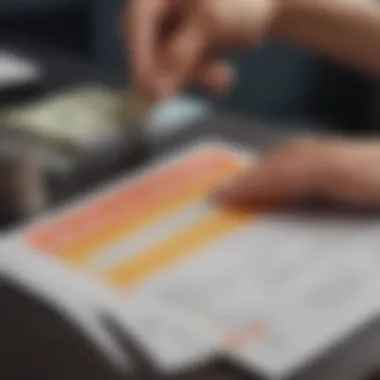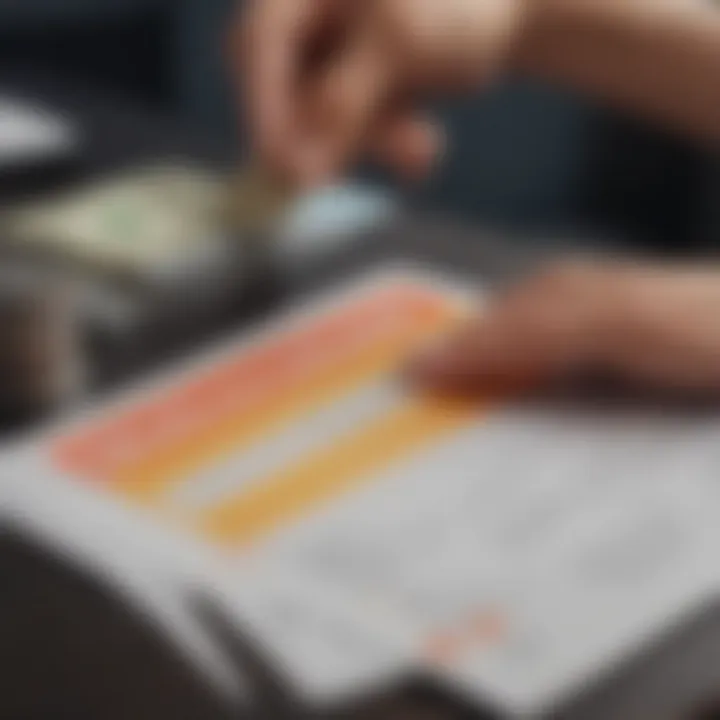Mastering Credit Card Debt: Strategic Repayment Methods


Intro
Credit card debt can feel like a weight that just won't budge. It lingers, bringing with it stress and an uncomfortable sense of obligation. However, it’s crucial to approach this scenario with clarity and strategy. Understanding the landscape is the first step in combating this financial challenge.
Many people find themselves unknowingly trapped in a cycle of minimum payments and accruing interest, leaving the principal balance mostly untouched. But there’s hope. There are numerous effective strategies to get a grip on credit card debt, allowing individuals to not only pay it off but to understand their spending habits and establish better financial practices.
In this article, we will walk through various approaches that can lead to debt elimination. From solid repayment plans to effective budgeting tactics, we'll shed light on the critical aspects you need to consider. Prepare to turn that cluttered pile of debt into a manageable, tackled burden.
The art of paying off credit card debt goes beyond just numbers; it encompasses a mindset shift, practical financial strategies, and the determination to forge a better path ahead.
Foreword to Credit Card Debt
Understanding credit card debt is crucial for anyone navigating the world of personal finance. It can be a slippery slope, easily leading individuals into financial chaos if not handled carefully. Credit cards offer convenience and immediate purchasing power; however, they come with substantial risks. Mismanagement can result in a cycle of debt that feels impossible to escape. Knowing how debt accumulates and how interest rates function is vital.
The repercussions of credit card debt extend beyond immediate financial strain; they can impact credit scores, making future borrowing more costly. Moreover, understanding the importance of strategic payoff methods can help individuals regain control over their finances.
Understanding the Nature of Credit Card Debt
Credit card debt often starts out innocently enough. You might make a few purchases, thinking, "I'll pay it off next month." However, life rarely goes according to plan. Unexpected expenses can crop up, and before you know it, you’re left with an outstanding balance. It's important to realize that credit card debt isn't just about the money you owe; it also reflects on your creditworthiness. When you carry balances, even if you’re making payments on time, it can raise flags with lenders.
Credit card debt operates under a revolving credit system. This means you can borrow a certain amount and continue to borrow as you pay some of it back. The ease of sliding a card to make a purchase can be alluring, but it often leads to overspending without immediate consequences.
Key Aspects to Consider:
- Revolving Credit: Understanding how much credit you have available versus how much you're actually using is crucial.
- Minimum Payments: Many people fall into the trap of making the minimum payment, thinking they're in good shape. However, this can lead to prolonged debt and additional interest charges.
- Fees and Penalties: Late fees can pile up quickly, exacerbating your debt situation.
The Impact of Interest Rates on Debt Growth
Interest rates can feel like a haunting specter when it comes to credit card debt. They can dramatically increase the amount you owe over time, making what seemed manageable quickly spiral out of control. Essentially, interest works like a snowball rolling down a hill, gaining momentum as it goes.
When you miss a payment or carry a balance, you're not just paying back the initial borrowed amount but also added interest. Percentages often range from moderate to exorbitant, especially if you have lower credit scores.
According to a recent study, the average credit card interest rate hovered around 15% – but this can vary significantly based on personal credit histories and the specific card. A high-interest rate debt is like treading water with an anchor tied to your foot.
Consider this:
- The longer you take to pay off the balance, the more interest accumulates.
- Paying just the minimum might feel manageable but often prolongs your debt repayment significantly.
- Finding a way to negotiate lower interest rates could save hundreds or even thousands over time.
"High-interest debt is like eating soup with a fork; it takes forever, and you might not get anywhere at all."
Assessment of Current Financial Situation
Understanding your financial situation is the bedrock upon which any effective debt repayment strategy rests. Without a clear picture of where you stand, attempting to pay off credit card debt can feel like wandering in a fog. This section dives into two crucial components: evaluating your total debt and interest rates, alongside recognizing your monthly cash flow limitations.
Evaluating Total Debt and Interest Rates
To tackle credit card debt head-on, start by getting a handle on the total amount owed. List every single credit card debt you have. Make note of the outstanding balance, the minimum payments due, and the interest rates attached to each card. It can be eye-opening to see it all laid out in front of you, much like pulling the wool from your eyes. This exercise isn’t just about tallying numbers; it’s about understanding the burden you’re carrying.
Once you have this information, prioritize your debts based on their interest rates. Higher interest debts cost you more over time. If you can, pay down those first. This concept is at the heart of the avalanche method. It’s like deciding to tackle the hardest problem in your math homework first – the rest often feels easier once that’s out of the way.


"Identifying your debts with their interest rates is like shining a flashlight on a dark path; it helps you see where you're going better."
Recognizing Monthly Cash Flow Limitations
While you’re becoming more familiar with your debts, the next step is to assess your cash flow. This means looking at your income and subtracting necessary living expenses like rent, groceries, and utilities. The aim here is to figure out what extra money, if any, you have each month that can be allocated toward paying off your credit card bills.
It’s important to be realistic. If your expenses often outstrip your earnings, look at areas where you can trim the fat. This could mean cutting down on entertainment, dining out, or even subscriptions you hardly use. Just remember, being savvy about spending now will allow you to take larger bites out of your debt later on.
For many, adjusting spending habits might feel like a tight squeeze at first, but it can be quite liberating. Making small changes can lead to significant improvements in your available cash flow over time.
In summary, by assessing your total debt alongside your monthly cashflow, you create a clearer roadmap toward financial freedom. It equips you with the necessary information to craft a repayment plan that is not only achievable but tailored to your circumstances.
Developing a Comprehensive Pay Off Plan
When it comes to tackling credit card debt, having a well-thought-out pay off plan is as crucial as it gets. A comprehensive approach not only provides a structural framework for repayment but also helps to maintain focus, reduce any anxiety associated with debt and, most importantly, paves the way for financial stability.
Creating a Realistic Budget for Debt Repayment
First and foremost, crafting a budget specifically tailored for debt repayment is step one in the right direction. A budget is more than just a set of numbers; it’s a plan that directs your spending and highlights areas where you can tighten your belt. Start by listing your monthly income and all your expenses, from rent to groceries, utilities, and leisure activities. Don't forget those little expenses that seem trivial but can add up—like that daily coffee run.
Once you've got a handle on where your money goes, it’s time to pinpoint how much you can allocate towards debt. The goal is to strike a balance between paying off your debt without falling into financial hardship. So perhaps you decide to cut back on dining out or limit shopping sprees. By being realistic about what you can afford, you set yourself up for success rather than disappointment.
Important Considerations:
- Emergency Fund: Try to keep some savings aside for unexpected expenses so you don’t have to reach for the credit card.
- Variable Expenses: Account for months that may require a bit more cash flow, like holidays or medical expenses.
- Set Milestones: Celebrate small victories as debts are paid off to keep the motivation alive.
Establishing Priorities: Which Debts to Pay First
Once the budget is in place, priorities come into play. Not all debts are created equal; understanding this will significantly impact your strategy. It’s wise to adopt either the avalanche or snowball approaches when determining which debts to tackle first.
The avalanche method suggests focusing on debts with the highest interest rates. By doing so, you minimize the total interest you pay, which can lead to a quicker overall debt-free status. On the other hand, the snowball method advocates for paying off the smallest debts first. This can create quick wins and boost your motivation, getting you into a momentum that really helps.
Decision Factors:
- Interest Rates: Take note of how much interest each debt carries. Are there any that are draining your wallet because they’re just hanging around?
- Emotional Impact: Sometimes, emotions play a role. Paying off a small debt gives a sense of accomplishment that can re-energize your efforts.
- Consider Long-Term Effects: Which method aligns better with your financial goals? Weigh both strategic moves accordingly.
"Commitment to your plan is key. One debt paid off can spark the fuel you need to keep going."
In weaving these elements together, a comprehensive pay off plan transforms from a mere document into a pathway to reclaiming financial independence. It’s not just about numbers on a page; it’s about building habits and shaping the future you want.
Debt Reduction Strategies
When it comes to paying off credit card debt, understanding various debt reduction strategies is critical. It's not just a matter of throwing money at your bills; having a solid strategy can significantly expedite the process and lighten the emotional burden associated with debt. These strategies can vary widely, each suited to different financial situations, preferences, and psychological tendencies.
Delving into your options equips you to make informed decisions that fit your lifestyle. Whether it’s understanding the mechanics behind the Avalanche Method or the practicality of the Snowball Method, knowing these strategies helps in narrowing down on the best approach for your circumstances. This section will explore these methodologies and others, weighing their merits and potential drawbacks.
Avalanche Method: Paying Off Highest Interest Debts First
The Avalanche Method is all about efficiency. Paying off the debts with the highest interest rates first can save you a chunk of change in the long run. Consider a typical scenario – you have three credit cards: one card with a balance of $5,000 at a 20% interest rate, another with $3,000 at 15%, and a third with $1,000 at 10%.


Instead of just chipping away at the minimums, the Avalanche Method encourages you to direct all extra funds towards the card accruing the highest interest, which in this case is the first one. Not only does this method cut down on total interest paid, but it can also shorten the payoff timeline, making your financial goals feel more attainable.
However, the catch here lies in the need for discipline. You might feel disheartened if the higher-balance card takes longer to clear, while the smaller cards might loom in the background, just waiting for your attention.
Snowball Method: Tackling Smallest Debts First
On the opposite end of the spectrum lies the Snowball Method. This approach is notably popular because it capitalizes on psychology rather than solely financial metrics. The idea is simple – pay off your smallest debts first.
For those who prefer quick wins, knocking out a couple of small balances can provide an immediate sense of gratification. Let's say you owe $500 on one card, $1,500 on another, and $2,500 on a larger debt. By paying off that $500 card first, you get that feeling of accomplishment, sparking motivation to tackle the next one.
While the Snowball Method may ultimately cost you more in interest over time, it builds confidence and establishes good debt repayment habits. It creates a cycle of success that can help maintain momentum when the climb feels steep.
Balance Transfer: Advantages and Risks
Balance transfer offers a third route, especially appealing to those with existing high-interest debt looking to consolidate. This strategy typically involves transferring your balance to a new credit card offering low or 0% interest during an introductory period.
While this might sound like a golden ticket, there are risks involved. If you fail to pay off the balance before the promotional rate expires, you could find yourself back in the high-interest trap. Plus, balance transfer fees may apply, cutting into potential savings. Nevertheless, utilizing a balance transfer effectively can lead to significant interest savings if approached with caution and a solid repayment plan.
In summary, choosing the right debt reduction strategy hinges on personal financial circumstances and psychological comfort levels. Each method has its unique benefits and setbacks that need careful consideration to tailor a plan that aligns well with your overall financial goals.
Utilizing Financial Tools and Resources
When it comes to managing credit card debt, utilizing financial tools and resources can be a game changer. These tools can help streamline the repayment process, offer insights into spending habits, and keep individuals accountable. The relevance of effectively harnessing these resources can't be overstated; they can transform financial chaos into manageable systems, fostering an environment where reaching debt goals becomes a tangible target.
Leverage Mobile Apps for Debt Management
In the digital era, mobile apps designed for debt management are plentiful and a reliable ally in conquering credit card debt. These tools can assist users in several meaningful ways:
- Budget Tracking: Apps enable individuals to set budgets that align with their income and expenses. By visually tracking spending, users can pinpoint areas where they can cut back, allowing for more funds to be directed toward debt repayment.
- Payment Reminders: Forgetting payment deadlines can lead to late fees and increased debt. Setting up alerts helps maintain consistency in payments and improves credit scores over time.
- Debt Visualization: Some apps provide dashboards that display total debt, interest rates, and progress toward repayment. This kind of visualization can motivate users, serving as a constant reminder of why they started their journey toward financial freedom.
A close look at popular apps like Mint or YNAB (You Need A Budget) shows they support users in tracking not just debts, but also overall spending, helping in maintaining a balance while aggressively paying off credit cards.
Seeking Guidance from Financial Advisors
While mobile apps can provide immense support, the value of professional guidance should not be underestimated. Meeting with financial advisors can bring distinct advantages:
- Tailored Strategies: Advisors can assess individual financial situations and craft personalized repayment plans, taking into consideration all aspects of one’s finances.
- Debt Negotiation: Sometimes, debts can be negotiated for lower interest rates or settlements. Advisors can leverage their experience and knowledge to contact creditors effectively, which a layperson may find intimidating.
- Comprehensive Financial Health: Advisors often look at the bigger financial picture, ensuring that debt elimination does not come at the expense of retirement savings or emergency funds. They can help maintain a balance that supports both short-term and long-term financial health.
The guidance from a skilled advisor could save you money in the long run and provide peace of mind along your journey toward debt freedom.
Overall, combining digital tools with the expertise of a financial advisor can create a fortified approach to credit card debt management. Both elements complement one another, leading to informed decisions and more effective strategies for repayment.
Psychological Aspects of Paying Off Debt
Understanding the psychological underpinnings of debt repayment is crucial, as debt is more than just numbers on a balance sheet; it often feels like a heavy cloud hanging over one's life. This section delves into the emotional tributaries that flow alongside credit card debt. Recognizing these aspects can bolster the motivation needed to rid oneself of debt and build a healthier financial future.
Understanding the Emotional Weight of Debt
Many people don’t recognize how deeply financial obligations can weigh on their mental health. The mere act of carrying debt can conjure feelings of anxiety, guilt, and even shame. This emotional burden may not only affect one’s perspective on personal finance but can seep into relationships and everyday interactions. It’s all too common to hear someone say, "I just can’t enjoy life when I’m tied down by bills."


When debt accumulates, it can morph into a psychological prison. Here are a few emotional impacts connected to credit card debt:
- Anxiety: The constant worry over monthly payments and interest rates can cause significant stress.
- Shame: Some individuals feel embarrassed about their financial status, fearing judgment from peers or family.
- Hopelessness: A mounting debt can lead to a sense of defeat, making one believe that escaping the situation is impossible.
Awareness of these feelings is the first step towards regaining control. It’s imperative to address these emotional consequences, perhaps by confiding in supportive friends or family or seeking professional guidance when necessary. Positive affirmations and self-compassion play important roles here, helping individuals to pivot their mindset from despair to determination in tackling their debt.
Building Motivation for Consistent Payments
Motivation is like a consistent companion on the journey to financial health. When the road feels long and daunting, finding that extra push to keep going can make all the difference. Here are a few methods that can help maintain motivation while paying off credit card debt:
- Set Clear Goals: Instead of merely wanting to "be debt-free," set specific milestones. For instance, aiming to pay off $1,000 within three months provides a defined target.
- Visualize Progress: Creating a visual representation of your debt payoff—like a graph or a chart—can help track your achievements. When you see that line going down, it uplifts your spirits.
- Celebrate Small Wins: Each payment is a step towards freedom. Celebrating these small victories, whether that’s treating yourself to a nice dinner or marking your progress in a journal, cultivates continued enthusiasm.
- Stay Informed: Keeping yourself educated about personal finance can also serve as a motivator. Reading articles or listening to podcasts about others who’ve succeeded can inspire hope.
"Budgeting isn't just about limiting your spending; it's about creating a vibrant, fulfilling life without being shackled by debt."
Additionally, connecting with community discussions—whether on forums like Reddit or local support groups—can provide the necessary encouragement and accountability. Sharing stories and tactics within a group can bolster commitment, creating a collective positive push towards financial stability.
Avoiding Future Debt Accumulation
Accumulating debt can feel like being on a treadmill—no matter how hard you try, you seem to be running in place. The ability to sidestep future debt is as crucial as paying off what you currently owe. Learning how to avoid falling back into the same trap ensures that all those efforts won’t go down the drain.
Implementing Smart Spending Habits
When it comes to staying away from debt, the focus should be on spending habits. Smart spending isn’t about depriving yourself; it’s about making conscious choices. Consider these techniques:
- Crafting a Spending Plan: A budget isn't just a fancy term; it's your financial roadmap. Take your income, essential expenses, and savings into account. When you allocate funds wisely, you can enjoy your favorite activities without overspending.
- Waiting for Purchases: The impulse buy is like a siren call. To combat it, adopt a rule that involves waiting—perhaps 24 hours—before making non-essential purchases. You might find that the desire fades.
- Cash Over Card: If plastic feels too tempting, switch to cash. Physically handing over cash can create a stronger connection to the money you're spending, making you more mindful.
Adopting these habits is a gradual process, much like trying to grow a garden. You plant the seeds, give them time, and nurture them into something beautiful.
Understanding the Use of Credit Wisely
Using credit doesn’t inherently mean racking up debt. It all hinges on how one handles it. An understanding of credit can set you apart, allowing you to utilize it as a tool rather than a noose. Here are some principles to consider:
- Know Your Limits: Keeping track of your credit utilization ratio—how much credit you're using compared to your total available credit—is vital. Aim to stay under 30%. This can help not only in avoiding debt but also in improving your credit score.
- Pay Off Balances Regularly: Instead of letting balances linger on your credit cards, prioritize paying them off monthly, or even bi-weekly. This not only helps prevent accruing high interest but also establishes a healthy relationship with credit.
- Use Rewards Credit Responsibly: If you’re using a rewards credit card, ensure that the benefits justify the spending and potential debt. Use them like a chess player; every move must be calculated to prevent a stressful checkmate.
Adopting these insights into your strategy can set a solid foundation for your financial health. Remember, the goal is not just to avoid debt but to build a secure and prosperous future.
Ending
As we reach the end of this exploration into credit card debt repayment, it's crucial to emphasize the significance of effective strategies. The strategies outlined earlier not only provide a road map for clearing the debt but also lay the groundwork for improved financial habits moving forward. Having a solid plan helps to minimize the burden of high interest payments, and ultimately, leads to a healthier financial future.
Recap of Effective Strategies for Debt Elimination
To briefly summarize the strategies discussed, here are some key pocket points to consider:
- Know Your Debt: Understanding your total debt and its interest rates can help in formulating a practical plan.
- Prioritize Payments: Whether you choose the avalanche or the snowball method, be clear about your priorities.
- Utilize Financial Tools: Mobile apps can be a game changer, offering insight and helping track your progress.
It's like having a personal trainer for your finances—someone keeping you accountable and on track. Don't forget that each payment you make chips away at the mountain of debt, leading you towards greater financial freedom.
Commitment to Financial Health Moving Forward
Establishing a commitment to financial health goes beyond just paying off existing debt. It’s about building behaviors that prevent future pitfalls. Consider implementing the following practices:
- Create a Sustainable Budget: This will help manage expenses and allocate funds towards savings or debt payment.
- Educate Yourself: Stay informed about personal finance through books or reputable online resources.
- Stay Disciplined: Remember, financial stability is a long game and needs unwavering commitment.
To sum up, by actively managing your debt and making informed spending choices, you cultivate a mindset of financial responsibility. As you embark on this path, keep in mind that discipline and mindfulness will serve you well on this journey to financial recovery. It’s a daily practice, one that pays dividends over time.



